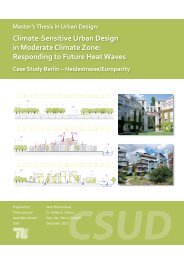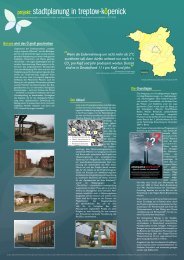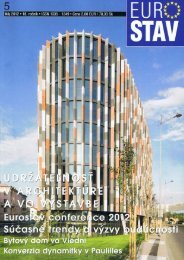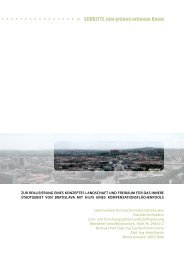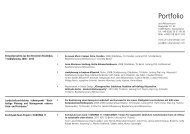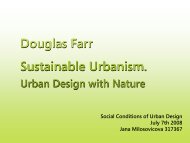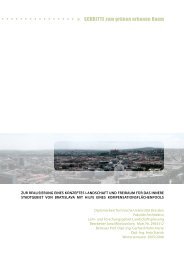Bausteine - Referate - Jana Milosovicova - Urban Design English
Bausteine - Referate - Jana Milosovicova - Urban Design English
Bausteine - Referate - Jana Milosovicova - Urban Design English
Erfolgreiche ePaper selbst erstellen
Machen Sie aus Ihren PDF Publikationen ein blätterbares Flipbook mit unserer einzigartigen Google optimierten e-Paper Software.
of seven points in LEED-ND.<br />
<strong>Design</strong> and Walkability<br />
LEED-ND criteria for walkable design include<br />
providing building entries on a street, square<br />
or park (not on a parking lot), creating at least<br />
a 1:3 building height-to-street-width ratio and<br />
providing continuous sidewalks. After meeting<br />
the first set of criteria worth four points, an additional<br />
four points can be earned for additional<br />
elements. These elements include: buildings located<br />
near the property line (within 0-25 feet<br />
or 0-8 meters), frequent building entries, limited<br />
blank walls along the street, ground floor retail,<br />
street parking and street trees. Another credit<br />
for is awarded for locating parking alongside or<br />
behind a building and not in front between the<br />
building and the street.<br />
LEED-ND also considers street density and connectivity.<br />
Points are given for the street network<br />
density within the project, as measured by street<br />
centerline miles per square mile. An additional<br />
credit is achieved for building a through-street<br />
every 800 feet (250 meters) along the project<br />
boundary, although exceptions are made for<br />
natural features such as water or streams and<br />
infrastructure such as highways or railroads.<br />
4. Conservation and Restoration<br />
of the Environment<br />
The Conservation and Restoration of the Environment<br />
category addresses impervious surfaces,<br />
stormwater management, groundwater<br />
quality, water bodies and habitat protection. The<br />
main goals are reducing and cleaning stormwater<br />
runoff, protecting habitat areas and limiting<br />
site disturbance.<br />
Water<br />
For impervious surface and stormwater treatment,<br />
LEED-ND calls for all stormwater to be<br />
infiltrated, reused or evapotranspirated for either<br />
90 percent of the average annual rainfall or<br />
1 inch (2.5 cm) of rainfall. Up to five points are<br />
awarded for the percentage of impervious surface<br />
treated in this manner. Rainwater absorption<br />
is given a high weight of 7 percent in the<br />
Assessment Matrix. The best score is given to<br />
projects if the amount of rainwater absorbed<br />
by the ground increases and filters pollutants in<br />
the process; the score declines as the amount of<br />
rainwater absorbed decreases. The Assessment<br />
Matrix measures the amount of impervious surface<br />
change, giving the best scores if there is no<br />
impervious surface change and worse scores if<br />
impervious surfaces increase. This reinforces a<br />
site selection of previously developed locations<br />
which have higher amounts of impervious surface.<br />
An areas with water bodies and wetlands, LEED-<br />
ND requires a minimal impact on the 100<br />
foot (30 meter) buffer around them. Another<br />
LEED-ND prerequisite is to either not build in<br />
a floodplain or if the area is previously developed,<br />
to follow federal recommended standards<br />
for floodplain development. LEED-ND also<br />
provides credits for water body and wetland<br />
conservation, restoration and management;<br />
however these credits can be earned either for<br />
water bodies and wetlands or for habitat (and<br />
are described below with Habitat). For surface<br />
water quality in the Assessment Matrix, the best<br />
score is achieved if water bodies in the area are<br />
improved; poor scores are given if water bodies<br />
become more impaired as a result of the plan.<br />
Habitat<br />
LEED-ND also offers points for the conservation,<br />
restoration and management of either water<br />
or habitat areas. Conservation efforts need<br />
to include all important natural habitats that<br />
can be identified (or alternately, all water bodies,<br />
wetlands and a 100 foot (30 meter) buffer). Restoration<br />
effects of these predevelopment conditions<br />
need to be 10 percent of the development<br />
footprint to achieve the credit. In addition<br />
to creating a management plan, it also needs to<br />
be funded for 10 years to reach the credit. The<br />
107



